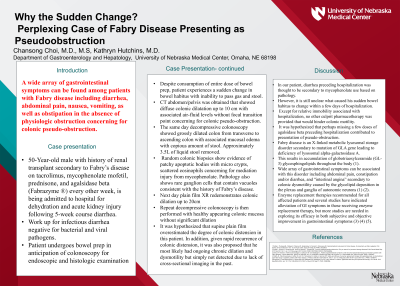Monday Poster Session
Category: Colon
P1728 - Why the Sudden Change? Perplexing Case of Fabry Disease Presenting as Pseudoobstruction
Monday, October 23, 2023
10:30 AM - 4:15 PM PT
Location: Exhibit Hall

Has Audio

Kathryn Hutchins, MD
UNMC / Nebraska Medicine
Omaha, NE
Presenting Author(s)
Chansong Choi, MD, MS1, Kathryn Hutchins, MD2
1UNMC, Omaha, NE; 2UNMC / Nebraska Medicine, Omaha, NE
Introduction: A wide array of GI symptoms can be found among patients with Fabry disease including diarrhea, abdominal pain, nausea, vomiting, as well as obstipation.
Case Description/Methods: 50-Year-old male with history of renal transplant secondary to Fabry’s disease on mycophenolate mofetil and agalsidase beta (Fabrazyme ®) is admitted to hospital for for a 5-week history of diarrhea. Work up for infectious diarrhea is negative. During hospitalization, he endorsed significant “gas pain” and colonoscopy is planned. Despite consumption of entire bowel prep, he experiences a sudden change in bowel habits with inability to pass gas nor stool. CT abdomen/pelvis showed diffuse colonic dilatation up to 10 cm with without focal transition point concerning for colonic pseudo-obstruction. The same day decompressive colonoscopy showed grossly dilated colon with mucosal edema with removal of 3.5L of liquid stool. Random biopsies show evidence of patchy apoptotic bodies with micro crypts concerning for medication injury from mycophenolate. Rare ganglion cells that contain vacuoles consistent with the history of Fabry’s disease. Next day supine XR abdomen shows reoccurrence of colonic dilatation up to 20 cm and repeat decompressive colonoscopy is performed. The 3rd day XR notable for reoccurence of colonic distension. It was hypothesized that supine plain film overestimated the degree of colonic distension in this patient.
Discussion: In our patient, diarrhea preceding hospitalization was contributed to mycophenolate use. However, it is still unclear what caused his sudden bowel habits to change within a few days of hospitalization. It was hypothesized that perhaps missing a few doses of agalsidase beta preceding hospitalization contributed to presentation of pseudo-obstruction in the background of chronic colonic dysmotility. Fabry disease is an X-linked metabolic lysosomal storage disorder secondary to mutation of GLA gene leading to deficiency of lysosomal alpha-galactosidase A. This results in accumulation of globotriaosylceramide (GL-3) glycosphingolipids throughout the body (1). Wide array of gastrointestinal symptoms can be associated with this disorder including abdominal pain, constipation and/or diarrhea, and "intestinal angina” caused by the glycolipid deposition in the plexus and ganglia of autonomic neurons (1) (2). Enzyme replacements are recommended for all affected patients as several studies have indicated alleviation of GI symptoms in those receiving enzyme replacement therapy. (3) (4) (5).
Disclosures:
Chansong Choi, MD, MS1, Kathryn Hutchins, MD2. P1728 - Why the Sudden Change? Perplexing Case of Fabry Disease Presenting as Pseudoobstruction, ACG 2023 Annual Scientific Meeting Abstracts. Vancouver, BC, Canada: American College of Gastroenterology.
1UNMC, Omaha, NE; 2UNMC / Nebraska Medicine, Omaha, NE
Introduction: A wide array of GI symptoms can be found among patients with Fabry disease including diarrhea, abdominal pain, nausea, vomiting, as well as obstipation.
Case Description/Methods: 50-Year-old male with history of renal transplant secondary to Fabry’s disease on mycophenolate mofetil and agalsidase beta (Fabrazyme ®) is admitted to hospital for for a 5-week history of diarrhea. Work up for infectious diarrhea is negative. During hospitalization, he endorsed significant “gas pain” and colonoscopy is planned. Despite consumption of entire bowel prep, he experiences a sudden change in bowel habits with inability to pass gas nor stool. CT abdomen/pelvis showed diffuse colonic dilatation up to 10 cm with without focal transition point concerning for colonic pseudo-obstruction. The same day decompressive colonoscopy showed grossly dilated colon with mucosal edema with removal of 3.5L of liquid stool. Random biopsies show evidence of patchy apoptotic bodies with micro crypts concerning for medication injury from mycophenolate. Rare ganglion cells that contain vacuoles consistent with the history of Fabry’s disease. Next day supine XR abdomen shows reoccurrence of colonic dilatation up to 20 cm and repeat decompressive colonoscopy is performed. The 3rd day XR notable for reoccurence of colonic distension. It was hypothesized that supine plain film overestimated the degree of colonic distension in this patient.
Discussion: In our patient, diarrhea preceding hospitalization was contributed to mycophenolate use. However, it is still unclear what caused his sudden bowel habits to change within a few days of hospitalization. It was hypothesized that perhaps missing a few doses of agalsidase beta preceding hospitalization contributed to presentation of pseudo-obstruction in the background of chronic colonic dysmotility. Fabry disease is an X-linked metabolic lysosomal storage disorder secondary to mutation of GLA gene leading to deficiency of lysosomal alpha-galactosidase A. This results in accumulation of globotriaosylceramide (GL-3) glycosphingolipids throughout the body (1). Wide array of gastrointestinal symptoms can be associated with this disorder including abdominal pain, constipation and/or diarrhea, and "intestinal angina” caused by the glycolipid deposition in the plexus and ganglia of autonomic neurons (1) (2). Enzyme replacements are recommended for all affected patients as several studies have indicated alleviation of GI symptoms in those receiving enzyme replacement therapy. (3) (4) (5).
Disclosures:
Chansong Choi indicated no relevant financial relationships.
Kathryn Hutchins indicated no relevant financial relationships.
Chansong Choi, MD, MS1, Kathryn Hutchins, MD2. P1728 - Why the Sudden Change? Perplexing Case of Fabry Disease Presenting as Pseudoobstruction, ACG 2023 Annual Scientific Meeting Abstracts. Vancouver, BC, Canada: American College of Gastroenterology.
